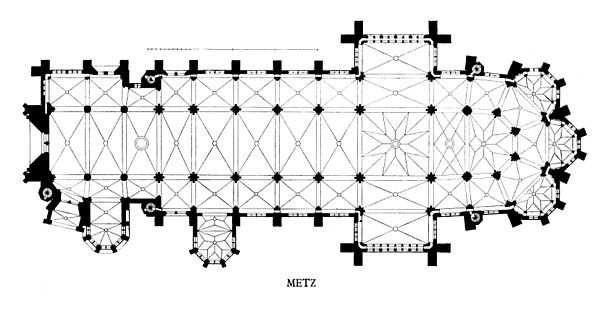Metz Cathedral
| Cathedral of Saint Stephen of Metz Cathédrale Saint Étienne de Metz | |
|---|---|
|
Saint Étienne de Metz at sunset. | |
| Basic information | |
| Geographic coordinates | 49°07′12″N 6°10′31″E / 49.12°N 6.1754°ECoordinates: 49°07′12″N 6°10′31″E / 49.12°N 6.1754°E |
| Affiliation | Roman Catholic Church |
| Region |
|
| State |
|
| District |
|
| Municipality |
|
| Year consecrated | 1552 |
| Ecclesiastical or organizational status | Cathedral |
| Status | Active |
| Leadership | Pierre Raffin |
| Website | |
| Architectural description | |
| Architectural type | Church |
| Architectural style | French Gothic; Gothic Revival |
| Direction of façade | West |
| Groundbreaking | 1220 |
| Completed | 1550 |
| Length | 136 metres (446 ft) |
| Width | 123.2 metres (404 ft) |
| Height (max) | 88 metres (289 ft) (Mutte tower) |
| Materials | Jaumont Stone |
| Official name: Cathédrale Saint Étienne de Metz | |
| Designated | 1930 |
| Reference no. | PA00106817[1] |
| Denomination | Église |
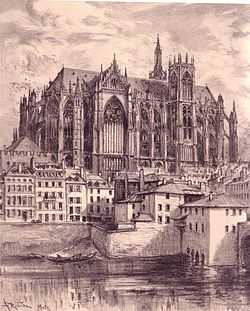
Saint-Étienne de Metz (French for "Saint-Stephen of Metz"), also known as Metz Cathedral, is a historic Roman Catholic cathedral in Metz, capital of Lorraine, France.[2] Saint-Étienne de Metz is the cathedral of the Roman Catholic Diocese of Metz and the seat of the Bishop of Metz, currently Pierre Raffin.[3] The cathedral treasury exhibits the millennium rich collection of the Bishopric of Metz, including paraments and items used for the Eucharist.[2][4][5]
Saint-Stephen of Metz has one of the highest naves in the world. The cathedral is nicknamed the Good Lord's Lantern (French: la Lanterne du Bon Dieu), displaying the largest expanse of stained glass in the world with 6,496 m2 (69,920 sq ft).[6] Those stained glass windows include works by Gothic and Renaissance master glass makers Hermann von Münster, Theobald of Lixheim, and Valentin Bousch and romantic Charles-Laurent Maréchal, tachist Roger Bissière, cubist Jacques Villon, and modernist Marc Chagall.[6]
Architecture
Cathedral all in volute where the wind sings as in a flute, and responding to it via the Mutte, this big voice of the Good Lord![7]
Saint-Stephen Cathedral is a Rayonnant Gothic edifice built with the local yellow Jaumont limestone. Like in French Gothic architecture, the building is compact, with slight projection of the transepts and subsidiary chapels. However, it displays singular, distinctive characteristics in both its ground plan and architecture compared to most of the other cathedrals. Because of topography of Moselle valley in Metz, the common west-east axis of the ground plan could not be applied and the church is oriented north-northeast. Moreover, unlike the French and German Gothic cathedrals having three portals surmounted by a rose window and two large towers, Saint-Stephen of Metz has a single porch at its western facade. One enters laterally in the edifice by another portal placed at the south-western side of the narthex, declining the usual alignment of the entrance with the choir.
The nave is supported by flying buttresses and culminates at 41.41 metres (135.9 ft) high, making one of the highest naves in the world. The height of the nave is contrasted by the relatively low height of the aisles with 14.3 metres (47 ft) high, reinforcing the sensation of tallness of the nave. This feature permitted the architects to create large, tall expanses of stained glass. Through its history, Saint-Stephen Cathedral was subjected to architectural and ornamental modifications with successive additions of Neoclassical and Neogothic elements.
Construction history
The edification of Saint-Stephen of Metz took place on an Ancient site from the 5th century consecrated to Saint Stephen protomartyr.[8] According to Gregory of Tours, the shrine of Saint Stephen was the sole structure spared during the sack of 451 by Attila's Huns.[9] The construction of the Gothic cathedral began in 1220 within the walls of an Ottonian basilica dating from the 10th century.[10][11] The integration into the cathedral's ground plan of a Gothic chapel from the 12th century at the western end resulted in the absence of a main western portal; the south-western porch of the cathedral being the entrance of the former chapel.[11][12] The work was completed around 1520 and the new cathedral was consecrated on 11 April 1552.[13]
In 1755, French architect Jacques-François Blondel was awarded by the Royal Academy of Architecture to built a Neoclassical portal at the West end of the cathedral. He disengaged the cathedral's facade by razing an adjacent cloister and three attached churches and achieved the westwork in 1764.[14][15]
In 1877, the Saint-Stephen of Metz was heavily damaged after a conflagration due to fireworks. After this incident, it was decided the refurbishment of the cathedral and its adornments within a Neogothic style. The western facade was completely rebuilt between 1898 and 1903; the Blondel's portal was demolished and a new Neogothic portal was added.[15]
Timeline of construction
- 984–c.1040 Construction of an Ottonian basilica on an ancient shrine dedicated to Saint Stephen[11]
- c.1180–1207 Construction of a chapel in Early Gothic style on the west side of the basilica[11]
- 1220 Beginning of the construction of the Gothic cathedral within the foundations of the Ottonian basilica, construction of the aisles[11]
- 1265–1285 Construction of the triforia and the two bell towers[11]
- 1285–c.1290 Elevation of the westwork within the foundations of a Gothic chapel from the 12th century[11]
- 1290s Construction of the vaults of the nave and the supporting flying buttresses[11]
- c.1300–1330s Construction of the Lady Chapel[13]
- 1380 Junction between the former Gothic chapel and the nave[13]
- 1384 Creation of the stained glass tympanum of the west facade and the rose window by master glass maker Hermann von Münster
- 1478–1483 Elevation of the spire[13]
- 1486–1490s Construction of the northern transept,[13]
- 1504 Creation of the stained glass tympanum of the northern transept by master glass maker Theobald of Lixheim
- c.1490–1500s Construction of the Gothics choir and East end[13]
- 1504–1520s Construction of the southern transept,[13]
- 1518-1539 Stained glass by master glass maker Valentin Bousch, including the tympanum on the southern transept.[16]
- 1761–1764 Neoclassical refurbishment conducted by Jacques-François Blondel[15]
- c.1850–1880s Destruction of the adornment of Jacques-François Blondel[15]
- 1889–1903 Construction of a Neogothic portal on the west front[15]
- 1958–1960 Stained glass windows of Marc Chagall
Architectural elements and ground plan

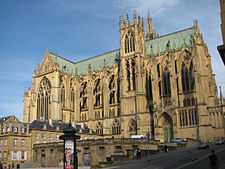




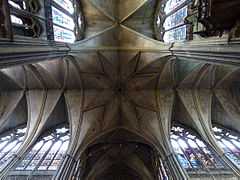

The following picture presents the ground plan of Saint-Stephen of Metz and the position of the architectural elements:
| Number | Architectural element | Plan of Metz Cathedral |
|---|---|---|
| 1 | Westwork | |
| 2 | Porch | |
| 3 | Portal Portal of the Virgin | |
| 4 | Narthex | |
| 5 | Side chapel Blessed Sacrament chapel | |
| 6 | Spire Mutte tower | |
| 7 | Lady Chapel | |
| 8 | Aisle | |
| 9 | Organ | |
| 10 | Southern transept | |
| 11 | Entrance of the crypt | |
| 12 | Apse chapel | |
| 13 | Ambulatory | |
| 14 | Apse (Chevet) | |
| 15 | East end | |
| 16 | Apse chapel | |
| 17 | Northern transept | |
| 18 | Aisle | |
| 19 | Bell tower Capitulum tower | |
| 20 | Altar candle | |
| 21 | Nave | |
| 22 | Crossing of the transept | |
| 23 | Altar | |
| 24 | Lectern | |
| 25 | Choir (choirstalls) | |
| 26 | Axis | The elements 1, 2, 4, 13, 14, 15, 19, 21, 22, 23, and 25 constitute the axis (south-southwest/north-northeast, respectively). On its exterior, the cathedral is 136 metres (446 ft) long. |
Stained glass
The stained glass windows, which together constitute the largest expanse of ancient stained glass in a single building, were made by the master craftsmen Hermann von Münster in the fourteenth century, and Valentin Bousch in the sixteenth. In the twentieth century the artist Marc Chagall created three stained glass windows for the cathedral between 1958 and 1968. Roger Bissière and Jacques Villon provided designs for further windows, including the complete chapel of the Holy Sacrament.
| Number | Master glass maker | Plan of Saint-Stephen of Metz |
|---|---|---|
| 1 | Hermann von Münster's windows | |
| 2 | Jacques Villon's windows | |
| 3 | Valentin Bousch's windows | |
| 4 | Valentin Bousch's windows | |
| 5 | Marc Chagall's windows | |
| 6 | Theobald of Lixheim's windows | |
| 7 | Marc Chagall's windows | |
| 8 | Roger Bissière's windows |
-cath%C3%A9drale_de_Metz.jpg)
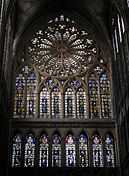
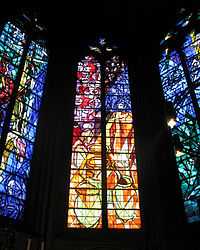
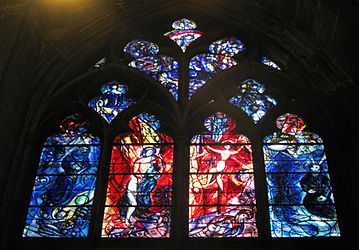
See also
| Wikimedia Commons has media related to Metz Cathedral. |
- List of highest church naves
- List of tallest churches
References
- ↑ "Merimee Data Base". Retrieved 2 January 2013.
- ↑ 2.0 2.1 "Official website of the Saint-Stephen Cathedral." (in French). Retrieved 29 June 2012.
- ↑ "Official website of the Bishopric of Metz." (in French). Retrieved 6 January 2013.
- ↑ "INA Archive (1969) Trésor de la cathédrale de Metz, Lorraine soir, ORTF" (VIDEO) (in French). Retrieved 2 July 2012.
- ↑ "INA Archive (1980) Patrimoine: trésor de la cathédrale de Metz, Lorraine soir, France 3 régions" (VIDEO) (in French). Retrieved 2 July 2012.
- ↑ 6.0 6.1 Jolin J.L. (2001) La lanterne du Bon Dieu. Eds. Serpnoise. ISBN 2-87692-495-1. (French)
- ↑ The Mutte is the name of the large bell of Metz Cathedral.
- ↑ Vallery-Radot J. (1931) La cathédrale de Metz, description archéologique. Eds A. Picard, Paris. (French)
- ↑ "Gregory of Tours (c. 538-594 A.D.) Historiae, Libri X. The Latin Library." (in Latin). Retrieved 6 January 2013.
- ↑ Marot P. (1931) La cathédrale de Metz, histoire de la construction. Eds A. Picard, Paris. (French)
- ↑ 11.0 11.1 11.2 11.3 11.4 11.5 11.6 11.7 "Timeline of the construction of Metz Cathedral, from 10th to 13th century." (VIDEO). Retrieved 6 January 2013.
- ↑ Villes A. (2004) Remarques sur les campagnes de construction de la cathédrale de Metz au XIIieme siecle. Bulletin Monumental 162, Paris. (French)
- ↑ 13.0 13.1 13.2 13.3 13.4 13.5 13.6 "Timeline of the construction of Metz Cathedral, from 14th to 16th century." (VIDEO). Retrieved 6 January 2013.
- ↑ Lejeaux J. (1931) La cathédrale de Metz, L'œuvre de Blondel à Metz. Eds A. Picard, Paris. (French)
- ↑ 15.0 15.1 15.2 15.3 15.4 "Timeline of the construction of Metz Cathedral, from 17th to 20th century." (VIDEO). Retrieved 6 January 2013.
- ↑ Ariane Isler-de Jongh: A Stained-Glass Window from Flavigny-sur-Moselle, Metropolitan Museum Journal, 33, 1998. Online, (p. 155).

